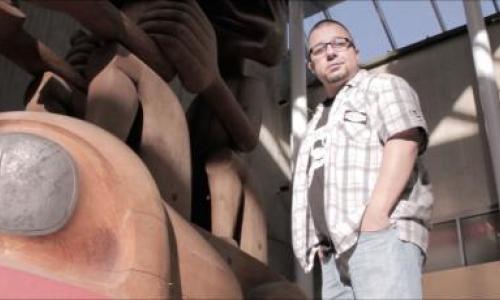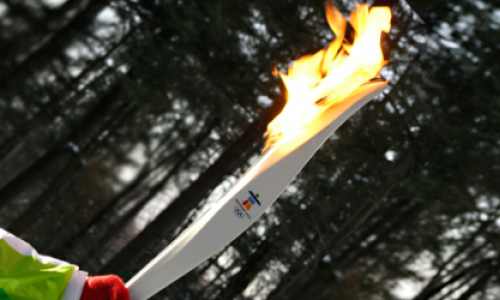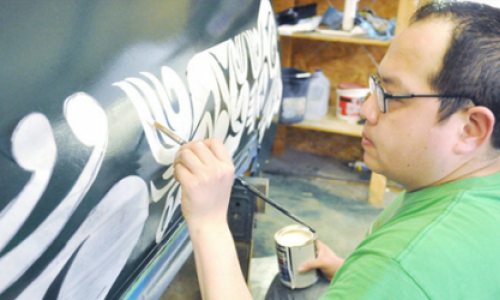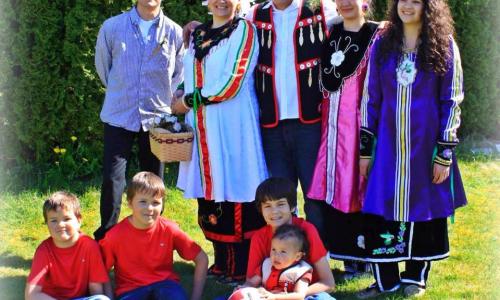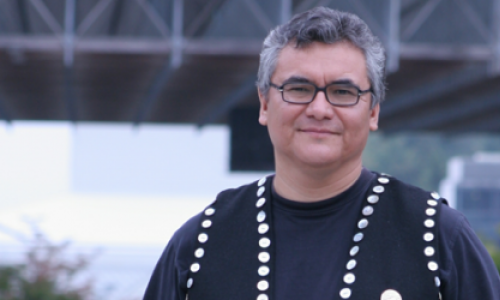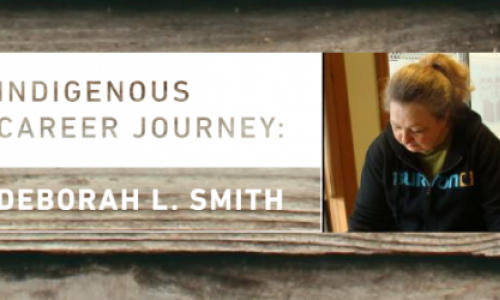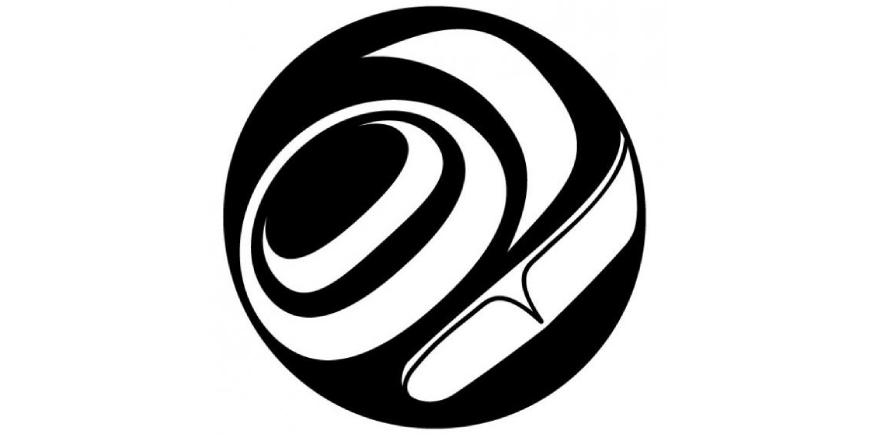
The Indigenous Research Institute promotes research in areas related to Indigenous peoples — in particular, the Aboriginal peoples of Canada — and in a larger context, those of the global community, and facilitates community-based projects with Indigenous partners. The Institute promotes research by bringing together the expertise of Indigenous individuals, groups, and organizations with that of the academic community, to engage in work that meets goals and objectives that is specified by and meaningful to both Indigenous and academic individuals and groups. A meaningful aspect of this process will be the facilitation of communication between Indigenous individuals/communities and the university. The Institute will also promote collaborative research projects within the university and will seek and support internal and external funding for the promotion and pursuit of such research.
Here is one of the IRI's members David Gaertner
David Gaertner is a postdoctoral fellow in the First Nations Studies Program at UBC. His research locates Canada’s Truth and Reconciliation Commission on Indian Residential Schools within the global history of the TRC, identifying and confronting the neo-colonial and neo-liberal assumptions of “first-world reconciliation.” By analyzing and comparing literature, art and film created by First Nations, Inuit and Métis peoples he investigates theories of apology, forgiveness and restitution based on Indigenous knowledge and maps them on to the “moral turn” of post-Cold War politics. David is currently studying Indigenous video art and interactive websites as spaces of hospitality in which to re-engage the notion of reconciliation.
David Gaertner is the recipient of a postdoctoral award from The Social Sciences and Humanities Research Council of Canada (SSHRC). He has a PhD in English Literature from Simon Fraser University and an MA in English from the University of Manitoba. He is the co-author of Practicing Reconciliation: a collaborative study of Aboriginal art, resistance and cultural politics (commissioned by the Truth and Reconciliation Commission on Indian Residential Schools). His article “‘The Climax of Reconciliation’: Transgression, Apology, Forgiveness and the Body in Conflict Resolution” was selected for a special reconciliation issue of Bioethical Enquiry. He is currently at work on his first book: Neoliberal Reconciliations: Reconciliation in the Canadian Context.
Please feel free to contact David at david.gaertner@ubc.ca.
How a White Guy got His Start in Indigenous Studies
My name is Dr. David Gaertner and I live and work as a guest on the unceeded, traditional and ancestral territory of the hən̓q̓əmin̓əm̓ -speaking Musqueam people. This is a true story of how a white guy started working in Indigenous studies.
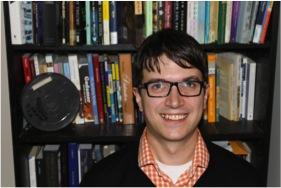
It’s important to tell your own story, and I value the opportunity. According to the Creek author Joy Harjo, the foundation of good protocol in Indigenous territory is self-identification. She writes, “protocol is a key to assuming sovereignty. It’s simple. When we name ourselves… we are acknowledging the existence of our nations, their intimate purpose, insure their continuation.” Secwepemc scholar Natalie Clark reframes Harjo’s protocol as a question: “who are you and why do you care?” I take this question and the responsibility of naming myself as a serious and ongoing process: the question of the name is not one that can be definitively answered at any one given time. Because they’re context-driven, identities and motives are in a constant state of flux: they move slowly overtop a mantle of bodily presence. I like to think of this process as similar to ‘plate tectonics’, a scientific theory that took what appeared to be ineradicably stationary (the ground under our feet), and illuminated the enduring amble of continental drift. Like the land beneath us, our identities drift and follow the currents of new relationships and communities, but the ground remains the same. It is a freeing realization to recognize that identity is in motion (however slowly), but it doesn’t release us from the responsibility of self-assessment or the obligation to probe our own privileges and motives—in fact, it highlights that identifying ourselves should be a persistent practice, one that we regularly revisit in our work and community engagement. Thus, following Harjo and Clark, I offer my name and my story here as a means of introduction and good protocol. But I also see this piece as a unique opportunity to re-think through—for myself—my own relationship to the work I do in Indigenous studies as a non-Indigenous ally. Below is the story that I usually tell when people ask me why I work in the field (which, surprisingly doesn’t happen very often), but now I’ve had a chance to inspect and expand its elements in the meditative presence of a blinking cursor. Here it is; it’s a true story, but it drifts a little every time I tell it.
When I was an English undergraduate at the University of British Columbia in the early 2000s, I thought I was going to be a Canadianist. I loved Timothy Findlay, Guy Vanderhaeghe, Margaret Atwood and Mordecai Richler. The first piece of literary criticism I ever wrote was on Shelia Watson’s The Double Hook. I once stayed up all night to read The Diviners because a professor told me that Margaret Laurence was a fundament of the CanLit Canon (and maybe she is; I’m still not sure). But in my early 20s, I had yet to read an Aboriginal author, and I doubt I could have named one if pressed. In fact, my awareness of Indigenous issues and my place as a settler on Indigenous land was exceedingly narrow. I had some friends who lived on the Semiahmoo Indian Reserve (Semiahmoo First Nation) and I’d been to the Museum of Anthropology, but that’s where my knowledge and engagement ended.
My intellectual path was forever altered, however, when I read Thomas King’sGreen Grass, Running Water. I loved (love) King because he was funny and smart and complex and political. He made me think critically about my commitment to Canadian nationalism and Canadian literature and my Canadianness itself and he made me aware of the depth and vitality of Indigenous arts and politics as they exist in the contemporary moment (as opposed to the historical past, as representations of what he elsewhere calls the “dead Indian”). Mostly, however, I loved King because he affirmed my love of literature and my innate sense (which had been clouded a bit by my very practical pre-med and engineering roommates) that stories are important.
There’s a line near the end of Green Grass where the narrator is having one of many arguments with Coyote. Coyote has just been off interfering with the lives of the novel’s main characters (King breaks a number of “fourth walls” in this book), but he insists that he was out saving the day: “That’s unlikely,” the narrator says. “‘No, no,’ says Coyote. ‘It’s the truth.” To which the narrator replies, “There are no truths, Coyote. Only stories.” I’ve read that line a number of times in the past fifteen years, and my students and I have interpreted it in a number of different ways, but generally what I take King to mean here is that stories, as opposed to Truth, Fact or Objective Reality, are at the foundation of our existence as social animals. This idea is certainly at the foundation of all King does—you can trace the import of story, as a trope, through the entirety of his work, from Medicine River all the way through to The Inconvenient Indian. For King, stories are not just produced by a community, they also produce and re-imagine that community. As such, they form the base of the work we do as thinkers, citizens, and community members. If you think about it like that, listening to, reading, and sharing stories is not simply a pastime, it’s the most primary means for us to engage with and make sense of the world around us. Stories are The Matrix, if you’ll excuse me from borrowing from a Keanu Reeves movie. For myself, an English student who was just starting to question why he was studying literature (other than because he likes it and he is not good at math), that was a powerful thing to read. I believe that swapping out Truth for stories, like King encourages, can make us better neighbours, relatives and ancestors, and that’s the main reason why I work in this field. Truths are cold and monolithic. They are hard and blunt, which makes them better weapons than medicines. Stories are dynamic and meant to be shared over food and drink with family and friends. They bring people together and if we treat them with respect, they can help us to “imagine otherwise,”—to quote my friend and mentor Daniel Heath Justice.
“The truth about stories,” King says in his Massey Lecture, “is that that’s all we are.” I think that’s true. Stories are the umbilical cords through which the complexity, wonder and subtlety of human experience are relayed. Stories are a way of pushing back against the centripetal force of subjectivity. Without them we risk collapsing inwards. I learned this my own way as an undergraduate. In order to fulfill my breadth requirements, my third year of classes was entirely devoid of Literature and I was busy with Biology, French, Psychology and Symbolic Logic. I was genuinely depressed and I wasn’t sure why. My days were full and I was learning, which—Symbolic Logic notwithstanding—I still assumed was inherently stimulating. It wasn’t until halfway through the fall semester that I realized it was because I had stopped reading stories. I have nothing against the Sciences (Social or otherwise), but it is difficult to connect humanly with a textbook; I was suffering from a lack of narrative and it was negatively impacting the rest of my life. In some ways it reflected the grey Vancouver weather (I am prone to the pathetic fallacy): I felt closed in and isolated, unconnected. Once I understood that stories were not an optional, that literature was something I should put on the list with food and sleep—and therefore not just a distraction from memorizing verb conjugation and marine phyla—I went to the bookstore. I bought King’s novel Truth & Bright Water that day because I knew from experience that he understood the importance of stories. Eight years later, I wrote a chapter of my dissertation on Green Grass and I keep that copy of Truth & Brightwater for the days when I forget why I am an academic.
To some extent I’ve set King’s work up here as if it were an antidote for white, middle-class ennui and I am cautious of those implications. Mainstream criticism (by which I namely mean newspaper book reviews) has the tendency to frame Indigenous literature as medicine for white guilt or as a distraction from the vertiginous spin of modernity. This is not the direction I want my work to go, but I also want to cut as close to the truth of my story as I can. I am “here” because I care about the stories and the change they represent. Assuming that narrative is only ever an opiate—another way of saying that aesthetics and politics are mutually exclusive—seriously underestimates the strength of Indigenous literature to transform its readers and contribute to decolonization. Indigenous literature is like any other field, inasmuch as there are good and bad texts. However, reading—and enjoying—creative work from Thomas King, Louise Halfe, Eden Robinson or Louise Erdrich is, in my opinion, a powerful act of sociopolitical immersion, which can lay the foundation for deeper engagement with Indigenous issues such as settler colonialism, sovereignty, land, and self-determination. In this sense, reading fiction (an act so often framed as passive engagement) is a very real kind of doing—it generates the cognitive space to question hegemony and ideology and “imagine otherwise.” There is plenty of fantastic scholarship out there that builds on this idea. Laura Tohe (Navajo), for instance, writes about the connections between Simon Ortiz’s (Acoma Pueblo) poetry and the defense of Laguna land against uranium mining. Dory Nason (Anishinaabe) has a beautiful piece on Indigenous women’s love and resistance that engages with the Dakota writer and activist Zitkala-Ša and her investigation into violence against women in Oklahoma Indian Territory. Neal McLeod (Cree) illustrates how Louise Halfe’s poetry “connects our living bodies to the living earth around us.”
Recently, my own research further accounts for literature as action by looking at the ways in which Indigenous artists are using technology to engage the abiding space between land and story. I am presently immersed in Indigenous New Media, which for me means sound and Internet art, podplays and interactive websites. I spend most of my time thinking, writing and talking about the connections and disjunctions between tradition and technology—what some, in order to deconstruct the binary that delineates the two words, frame as “traditional innovation.” For example, in my Indigenous New Medias course we look at Quelemia Sparrow’s (Musqueam) podplay “Ashes on the Water.” Podplays are recorded pieces of site-specific “theatre” that audiences download onto portable listening devices, like an iPhone. Following a map, audiences travel to a specific location (in this case Vancouver’s Crab Park, known asSnauq by many Musqueam, Squamish and Tsleil Waututh) and a downloadable audio file guides them on a walking tour of that place while layering a narrative overtop of the journey. Sparrow’s piece is about Great Fire of 1886 and how the First Nations canoed from the North Shore to rescue settlers who were forced into the Burrard Inlet on the Vancouver side. It is based on the story of the Coast Salish Women’s Paddle Song that was composed out of that event and it indigenizes a space that has otherwise—in the fashion of settler colonialism—repressed its rich Coast Salish history.
Podplays compel audiences to consider the relationship between storytelling and place, challenging us to critically engage with the ways in which our own languages and stories are positioned in relation to the land, Indigenous peoples and Western ideology. In a West Coast Line interview I did with the co-producers of “Ashes” Adrienne Wong suggested that these pieces of theatre form “a direct relationship between the story and site.” “Ashes” takes the practice of literature outside of the classroom and onto the land. This is a vital component of Indigenous studies, which the traditional classroom rarely provides for. The Okanagan writer and scholar Jeanette Armstrong tells us that, “the land speaks. It is constantly communicating. Not to learn its language is to die.” Western literary theory is so often about the distinction between the word and the thing it represents (“tree” is not a tree is Ferdinand de Saussure’s famous example), but in her work Armstrong asks us to consider the intimate relationship between language (both English and N’silxchn) and the environment, proffering a more immediate ecological responsibility between reader, writer and text. Similarly, Leslie Marmon Silko (Laguna Pueblo) suggests, “stories are, in a sense, maps.” In other words, stories describe unique relationships with a given environment, be it rural or urban, pre- or post-contact.
Understanding the multifarious ways in which stories orient (and disorient) readers is a political gesture: decolonization requires that we engage with space in alter-native ways, that we shake ourselves free of the Imaginary borders that imperialism and capitalism have writ Real. New Media pieces such as “Ashes on the Water,” as well as work from Kevin Lee Burton (Swampy Cree), Cheryl L'Hirondelle (Métis/Cree-non status/treaty, French, German, Polish), Bear Witness (Cayuga Six Nations), Skawennati Tricia Fragnito (Mohawk) and Jason Lewis (Cherokee), among others, offer rich and challenging ways for Indigenous peoples and non-Indigenous allies to physically (re)locate themselves in relationship to both new and familiar landscapes, both physical and political, urban and rural. Settler colonialism works to obscure these relationships and the arts can revitalize them in surprising, rigorous and enriching ways.
I have encountered an enormous amount of intellectual and emotional generosity as a student and teacher in this field, from authors, scholars, Elders and community members. I try to follow a research practice that lives up to the generosity I have been afforded by respecting Indigenous sovereignty and reinforcing Indigenous ways of knowing. Engaging respectfully with the land in the context of Indigenous peoples is good protocol, and technology and Indigenous talent is generating new and exciting ways to initiate this engagement. I started working in this field out of a love for storytelling and I continue to encounter Indigenous stories, in all shapes and forms that challenge me to be a better academic, ally, and community member. I am especially grateful to the Social Sciences and Humanities Research Council and the First Nations Studies Program at UBC, for providing me with the opportunity and resources to continue reading and learning in the company of so many great scholars.
Thank you for the opportunity to share my story here. It’s a true story, but I’ll probably tell it differently next time.
More About David
David Gaertner has a PhD in English Literature from Simon Fraser University and an MA in English from the University of Manitoba. He has authored articles, book chapters and special reports on Canadian literature, Indigenous literature, Reconciliation Studies and Cultural Studies, including "Indigenous in Cyberspace: CyberPowWow, God’s Lake Narrows and the Contours of Online Indigenous Territory" forthcoming in the American Indian Culture and Research Journal. His article “‘The Climax of Reconciliation’: Transgression, Apology, Forgiveness and the Body in Conflict Resolution” is published in the inaugural issue of Bioethical Enquiry. He has also published in English Studies in Canada, SHIFT and Psychoanalysis, Culture and Society and a number of edited collections, most recently Translation Effects: The Shaping of Modern Canadian Culture.In 2013, he co-authored Practicing Reconciliation: A Collaborative Study of Aboriginal Art, Resistance and Cultural Politics, a study commissioned by the Canadian Truth and Reconciliation Commission and with Jason Starnes he co-edited a special edition of West Coast Line entitled Here Comes the Neighbourhood, a collection of essays, poems and photographs that unpack the Freudian idea of the neighbor as it plays out in Vancouver's sociopolitical and aesthetic spaces. He is currently at work on his first book: Neoliberal Reconciliations: Reconciliation in the Canadian Context and is a co-editor of the forthcoming anthology of Indigenous short fiction, Stories Are All That We Are: Indigenous Literature From Turtle Island.
David is a SSHRC Postdoctoral Fellow in the First Nations Studies Program at the University of British Columbia where he teaches and conducts research on Indigenous arts and literatures in Canada.
Beyond the Blog
-
Visit David's website to learn more information, including links to David’s Teaching Portfolio, C.V., and blog.










